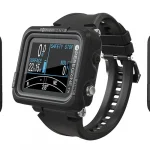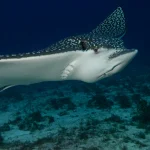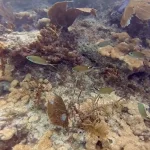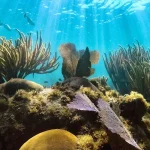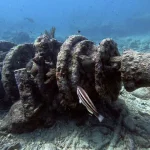Table of Contents
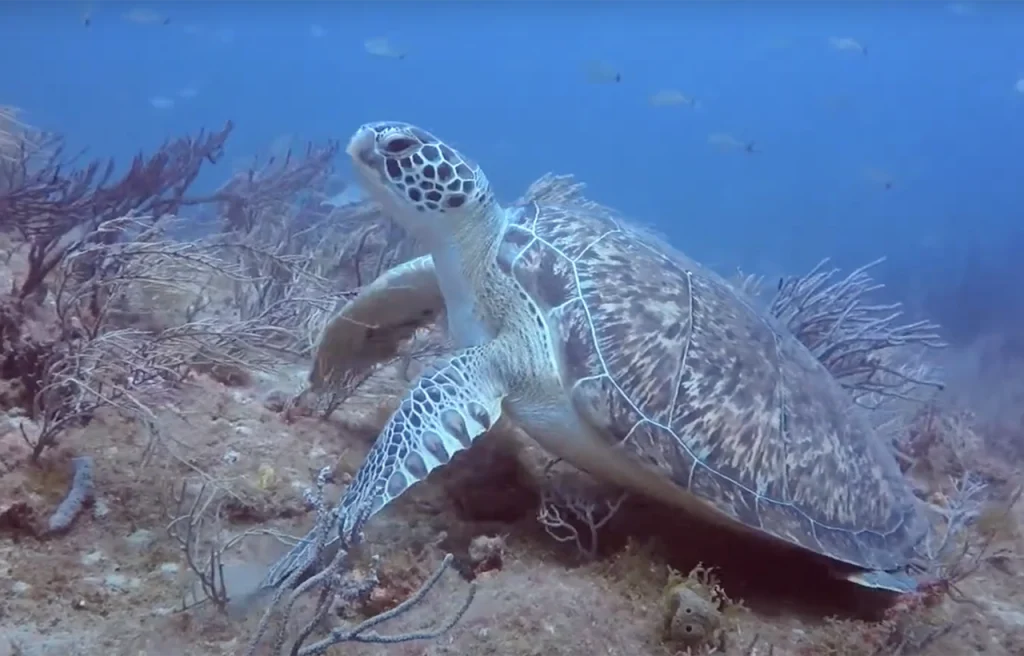
Captain Kurls is consistently praised for its combination of stunning underwater landscapes, abundant marine life, and overall enjoyable diving conditions.
Article at a Glance
- Location: Captain Kurls is situated in Jupiter, Florida, known for its vibrant marine ecosystem.
- Depth: Dives typically occur at depths of 65 to 75 feet (20 to 23 meters), suitable for both beginners (with guidance) and advanced divers.
- Visibility: Divers can expect visibility ranging from 30 to 60 feet (10 to 20 meters), enhancing the underwater experience.
- Best Time to Dive: The ideal diving season is late summer to early fall, particularly from mid-August to September, coinciding with Goliath Grouper aggregations.
- Marine Life: The site is home to diverse marine species, including Goliath Groupers, Hawksbill turtles, moray eels, nurse sharks, and various reef fish.
- Unique Features: Captain Kurls offers varied topography with multiple ledges and interesting blow-outs, providing ample opportunities for exploration and photography.
- Recommended Operators: Local dive operators like Jupiter Scuba Diving and Kyalami Charters offer guided dives, ensuring safety and enriching the diving experience.
Captain Kurls Jupiter
Captain Kurls is a popular dive site located in Jupiter, Florida, nestled between “Scarface” and “Loggerhead” at a depth of 65-75 feet. This site offers divers a diverse underwater experience with its unique topography and rich marine life.
Dive Site Features
The dive site is characterized by:
- A ledge that breaks off into three major tiers
- Varied topography with cul-de-sacs and interesting blow-outs
- Western ledge suitable for potential spear fishing
- Eastern terrace with numerous cul-de-sacs and blow-outs
Dive Experience
The dive at Captain Kurls offers:
- Variety in exploration due to its three-tiered structure
- Opportunities for both marine life observation and potential spearfishing
- A mix of ledge diving and sandy bottom exploration
What Marine Life Can I Expect To See?
- Hawksbill Sea Turtles: These curious turtles are a favorite among divers and are commonly spotted at this site.
- Loggerhead Sea Turtles: Another turtle species frequently seen in the area, adding to the site’s appeal for turtle enthusiasts.
- Goliath Grouper: Large and impressive, these groupers are often found resting on the ledges and are a highlight for many divers.
- Moray Eels: Various species of moray eels can be seen hiding in crevices and amongst the rocks.
- Nurse Sharks: These gentle sharks are often spotted resting on the sandy bottom or among the ledges.
- Hogfish and Snapper Species: Ideal for those interested in spearfishing, these fish can be tracked along the western ledge.
- Other Tropical Fish: The site is home to numerous reef fish, contributing to a vibrant underwater environment.
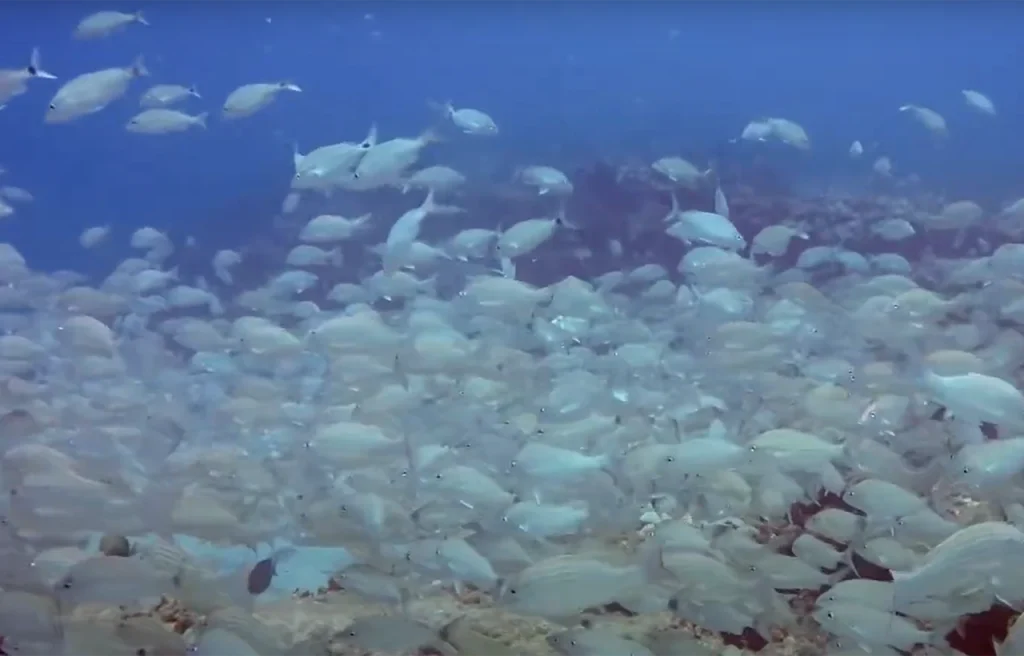
What Do Divers Say About This Site?
General Impressions
- Friendly and Professional Staff: Many divers commend the helpfulness and friendliness of the crew from dive centers like Jupiter Scuba Diving and Kyalami Charters. They describe the staff as personable and attentive, fostering a welcoming atmosphere for both novice and experienced divers.
- Safety and Comfort: Safety is a recurring theme in reviews, with divers expressing confidence in the crew’s expertise and adherence to safety protocols. This is particularly appreciated by those who are new to diving, as it enhances their overall comfort during dives.
Dive Experience
- Marine Life Encounters: Divers frequently mention the rich marine life at Captain Kurls, including sightings of Goliath Groupers, sea turtles, and various reef fish. These encounters contribute to an exciting and memorable diving experience.
- Site Characteristics: The unique topography of Captain Kurls, with its multiple ledges and interesting blow-outs, is often noted as a highlight. Divers appreciate the variety it offers for exploration, making it a site worth visiting multiple times.
Specific Feedback
- Great Visibility: Many reviews mention good visibility during dives, which enhances the overall experience by allowing divers to fully appreciate the underwater scenery and marine life.
- Comfortable Dive Boats: Divers have praised the spaciousness and amenities of the dive boats used for trips to Captain Kurls, which adds to the enjoyment of the overall experience.
Key Information
| Feature | Details |
|---|---|
| Location | Jupiter, Florida |
| Depth | 65 to 75 feet (20 to 23 meters) |
| Visibility | 30 to 60 feet (10 to 20 meters) |
| Best Time to Dive | Late summer to early fall (August to September) |
| Marine Life | Goliath Groupers, Hawksbill and Loggerhead Turtles, Moray Eels, Nurse Sharks, various reef fish |
| Suitable For | Beginners (with certification and guidance), Advanced Divers |
| Dive Conditions | Mild currents, generally favorable visibility |
| Unique Features | Multiple ledges, interesting blow-outs, potential for spear fishing |
| Recommended Dive Operators | Jupiter Scuba Diving, Kyalami Charters |
Highlights of Diving This Site?
Varied Topography
- Multiple Ledges: The site is characterized by three major tiers of ledges, providing diverse underwater landscapes for exploration. This varied topography includes interesting blow-outs and cul-de-sacs that enhance the diving experience.
- Depth Range: Captain Kurls is situated between 65 to 75 feet deep, making it accessible for both beginner and advanced divers while still offering the thrill of deeper dives.
Rich Marine Life
- Diverse Species: Divers can expect to encounter a variety of marine life, including Hawksbill and Loggerhead sea turtles, Goliath groupers, moray eels, nurse sharks, and various species of snapper and hogfish. This rich biodiversity makes every dive unique and exciting.
- Spear Fishing Opportunities: The western ledge is known for potential spear fishing, attracting those interested in catching local fish species while diving.
Excellent Visibility and Conditions
- Visibility: Typically ranging from 30 to 60 feet, the visibility at Captain Kurls allows divers to fully appreciate the vibrant underwater scenery and marine life.
- Favorable Dive Conditions: The site generally experiences mild currents, which are favorable for divers of all skill levels. This contributes to a more enjoyable and less strenuous diving experience.
Memorable Experiences
- Frequent Sightings: Many divers report memorable encounters with large marine animals like Goliath groupers and sea turtles, often highlighting these moments as the best parts of their dives.
- Exploration Potential: The unique structure of the dive site encourages exploration, with divers often discovering new features and marine life on each visit. The layout promotes a sense of adventure as divers navigate through the ledges and overhangs.
My Favorite Dive Computers
I have compared the 3 top diving computers for each category to help making the right choice easier:
Iconic Spots At This Site
Western Ledge
- Description: This ledge offers potential spear fishing opportunities, where divers can track hogfish and various snapper species.
- Unique Features: The western ledge eventually tapers off into a sandy bottom, requiring divers to navigate back east to continue exploring.
Eastern Terrace
- Description: Rich with cul-de-sacs and interesting blow-outs, this area is known for its vibrant marine life.
- Notable Sightings: Divers frequently encounter Hawksbill sea turtles here, making it a favorite spot for turtle enthusiasts.
Goliath Grouper Encounters
- Description: Diving straight down the barrel of the site often leads to encounters with large Goliath groupers.
- Experience: These impressive fish are a highlight for many divers, adding excitement to the dive.
Diverse Marine Life
- Description: Beyond Goliath groupers and turtles, divers can expect to see moray eels, nurse sharks, and a variety of reef fish.
- Ecological Significance: The site’s rich biodiversity contributes to its reputation as an excellent dive location.
Unique Topography
- Description: The site features multiple tiers and ledges that create an engaging environment for exploration.
- Exploration Opportunities: Divers can enjoy navigating through overhangs and rocky structures filled with marine life.
Environmental Conservation Efforts at Captain Kurls
Conservation Initiatives
Dive Against Debris
Captain Kurls has been a site for Dive Against Debris surveys, which involve divers collecting and reporting marine debris. In April 2012, a team of 14 divers conducted a 45-minute survey, collecting 20 lbs of debris from an area of 15,000 square feet (1).
Responsible Diving Practices
Dive operators in Jupiter promote responsible diving etiquette to minimize impact on the marine environment:
- Maintaining proper buoyancy control to avoid damaging coral and disturbing marine life
- Avoiding touching or chasing marine creatures
- Moving slowly to prevent stirring up sediment
Marine Life Protection
The site is known for its diverse marine life, including endangered species. Divers are encouraged to report sightings of rare species, contributing to conservation efforts and research.
Broader Regional Efforts
Loggerhead Marinelife Center (LMC)
Located in the Jupiter area, LMC conducts significant conservation work:
- Operating a sea turtle hospital for rehabilitation
- Using satellite trackers on rehabilitated turtles for research
- Offering educational programs to raise public awareness
- Collaborating with global partners on sea turtle conservation (2)
Coral Reef Conservation
Florida’s coral reef initiatives focus on:
- Protecting and restoring coral reefs (3)(4)
- Reducing pollution
- Enhancing reef resilience to climate change
- Monitoring water quality and ecosystem health
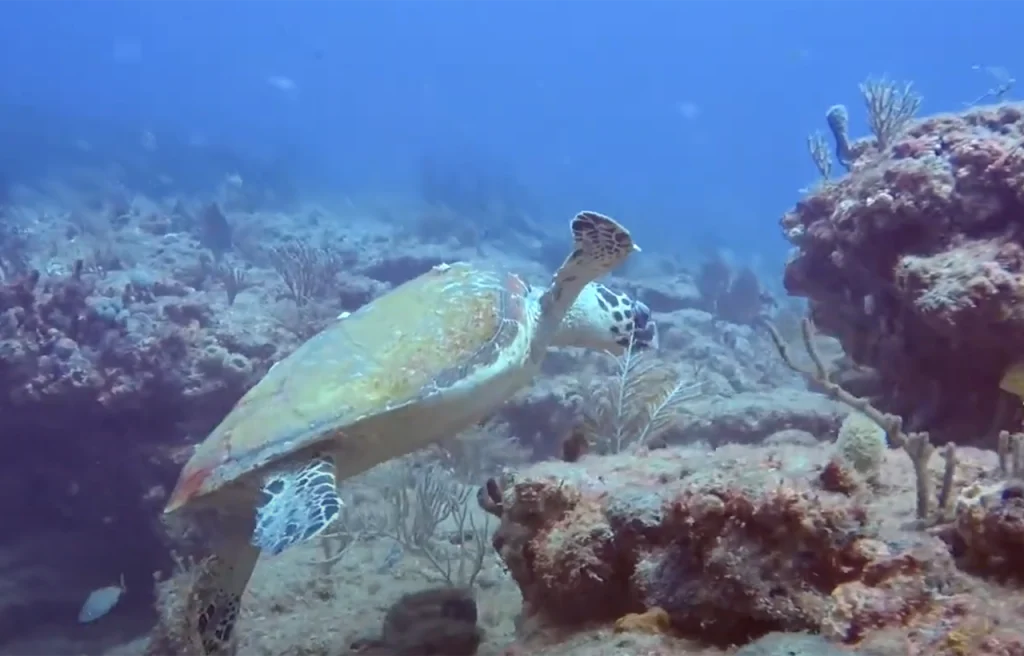
Maximizing Your Diving Experience at Captain Kurls
Dive Techniques
- Navigate Carefully: Follow the western ledge for potential spear fishing opportunities, but be prepared to move east when the ledge tapers off into sandy bottom
- Explore Multiple Tiers: The site features three major ledge tiers, offering diverse exploration possibilities
- Go Slow: Drift diving can rush the experience, so move deliberately to fully appreciate the marine environment
Marine Life Encounters
- Dive “Down the Barrel”: This approach increases chances of encountering:
- Goliath Groupers
- Loggerhead Sea Turtles
- Moray Eels
- Nurse Sharks
Strategic Locations
- Western Ledge: Best for tracking hogfish and snapper species
- Eastern Terrace: Loaded with cul-de-sacs and blow-outs, ideal for discovering Hawksbill Sea Turtles
Recommended Dive Conditions
- Depth: 65-75 feet
- Best Visibility: Typically 30-60 feet
- Recommended Approach: Drift diving with controlled, slow movements
Capturing Memories at Captain Kurls: Photography Tips
Get Close to Your Subject
- Proximity Matters: Water reduces color and clarity, so aim to be within 12 inches of your subject for the best results. This minimizes the amount of water between your lens and the subject, enhancing detail and color vibrancy.
Utilize Proper Lighting
- External Strobes: Use an external flash or strobe to illuminate your subjects effectively. The natural light diminishes quickly underwater, especially at greater depths, making artificial lighting crucial for capturing vibrant colors (6)
- Focus Lights: Consider using a focus light to help with contrast and visibility while framing your shots. This can also serve as your primary light source during dives.
Experiment with Angles
- Eye Level Shots: Position your camera at eye level with marine life to create a more engaging perspective. This approach fosters a stronger connection between the viewer and the subject.
- Unique Perspectives: Shoot from various angles—try low shots that capture the subject against the backdrop of the water surface or surrounding marine life for dynamic compositions.
Use Natural Light When Possible
- Golden Hours: Take advantage of natural light during shallow dives, especially during early morning or late afternoon when sunlight is softer. This can create beautiful lighting effects and enhance colors in your photos (5).
Practice Your Diving Skills
- Comfort in Water: Being relaxed and confident in your diving abilities is essential. It allows you to focus on photography without stressing out marine life or compromising your safety.
- Familiarize with Your Gear: Before diving, practice using your camera in its housing topside to become familiar with its settings and controls. This preparation will help you make quick adjustments underwater.
Mind Your Composition
- Fill the Frame: Try to fill your frame with the subject rather than centering it; this creates more visually compelling images. Avoid shooting directly down at subjects; instead, aim for upward angles whenever possible.
- Background Consideration: Pay attention to your background; a clean background can enhance the subject’s visibility and overall composition.
Be Respectful of Marine Life
- Avoid Disturbance: Approach marine animals slowly and respectfully to avoid startling them, which can lead to better photo opportunities as they remain calm and natural in their behavior.
Frequently Asked Questions
When is the best time to dive Captain Kurls?
The best time to dive at Captain Kurls in Jupiter, Florida, is generally during the summer and early fall months, particularly from mid-August to September. This period coincides with the annual Goliath Grouper aggregation, which attracts a variety of marine life and enhances diving experiences.
Seasonal Overview
Summer (June to August): Water temperatures are warm, typically around 26-28°C (79-82°F), and visibility is often good, making it comfortable for divers. Expect mild currents and a rich diversity of marine life.
Fall (September): This month marks the peak for Goliath Grouper sightings, as these large fish gather in significant numbers. Visibility remains good, and water temperatures are still warm.
Additional Considerations
Winter (December to February): While diving is possible year-round, winter months can bring cooler water temperatures (around 22-24°C or 72-75°F) and variable visibility. However, this season may also provide opportunities to see different species like Lemon Sharks.
Spring (March to May): Spring offers mild conditions but may have slightly cooler water temperatures as the season transitions. Visibility can vary but is generally acceptable for diving.
What is the visibility like while diving Captain Kurls?
Visibility while diving at Captain Kurls typically ranges from 30 to 60 feet (approximately 10 to 20 meters), depending on various environmental factors such as water temperature, currents, and seasonal conditions.
Seasonal Visibility Insights
Summer and Early Fall: During these months, visibility tends to be at its best, often reaching the upper end of the range. Warm water temperatures and favorable weather conditions contribute to clearer waters.
Winter Months: Visibility can vary more significantly, sometimes dropping to around 10 feet during colder months due to potential algal blooms or increased sediment.
How deep are the dives at Captain Kurls?
Dives at Captain Kurls typically occur at depths ranging from 65 to 75 feet (approximately 20 to 23 meters). This depth provides divers with a variety of topographical features to explore, including ledges and rocky structures, while also allowing for encounters with diverse marine life. The site is well-suited for both novice and experienced divers, offering a rich underwater experience.
Is Captain Kurls suitable for beginners?
Captain Kurls can be suitable for beginners, but there are important considerations to keep in mind:
Depth and Conditions
Depth: The site is located at depths of 65 to 75 feet (approximately 20 to 23 meters), which is deeper than many beginner-friendly dive sites. While certified divers can dive to these depths, beginners should ideally have some experience and comfort with deeper dives.
Visibility: Visibility typically ranges from 30 to 60 feet, which is generally favorable for diving, allowing beginners to see and appreciate the marine life without feeling overwhelmed.
Recommended Experience
Certification Level: Beginners should ideally have at least an Open Water certification, as they will need to be comfortable managing buoyancy and navigating at deeper depths.
Guided Dives: Joining a guided dive with experienced instructors can enhance safety and provide valuable learning opportunities. Dive operators often tailor experiences based on the skill levels of participants.
Marine Life and Exploration
Diverse Ecosystem: The site offers rich marine life, including turtles, Goliath groupers, and various reef fish, which can be exciting for new divers. However, beginners should be cautious not to disturb marine life or damage the coral structures.
Is Captain Kurls suitable for advanced divers?
Yes, Captain Kurls is highly suitable for advanced divers. Here are several reasons why this dive site appeals to those with more experience:
Depth and Exploration
Depth Range: The site is located at depths of 65 to 75 feet, which is within the comfort zone for advanced divers who are trained to handle deeper dives and varying conditions.
Varied Topography: Captain Kurls features multiple ledges and interesting blow-outs, providing ample opportunities for exploration and adventure. Advanced divers can enjoy navigating through these structures and discovering unique underwater features.
Marine Life Encounters
Diverse Species: Advanced divers can expect to see a wide range of marine life, including Goliath groupers, Hawksbill sea turtles, moray eels, and nurse sharks. The abundance of large marine animals adds excitement to the dive experience.
Spear Fishing Opportunities: The western ledge offers potential spear fishing experiences, appealing to advanced divers looking for an active engagement with the underwater environment .
Thrilling Experiences
Unique Dive Conditions: The site allows for drift diving and exploration of deeper waters, catering to the skills of advanced divers who seek more challenging conditions.
Potential for Unique Sightings: Advanced divers may also have the chance to encounter pelagic species or participate in seasonal events like Goliath Grouper aggregations, further enhancing their diving experience.
Jupiter Dive Sites
- Area 51
- Area 29
- Tunnels
- Loggerhead Reef
- Bluffs Reef
- Bonnies
- Captain Kurls
- Spadefish Point
- Coral Cove Park
- Captain Mike’s
- Julies
- Emerald Charters Shark Dive
- Jupiter Wreck Trek
- Donut
- Scarface Reef Andrew “Red” Harris No Shoes Reef
- Jupiter Inlet
- Step Reef
- Sawfish Bay
- Marine Restoration Reef
- North County Reef
- Lighthouse
- Finz Den
- High Ledge
- Leigh’s Ledge
- Monkey’s Ledge
- Gary’s

